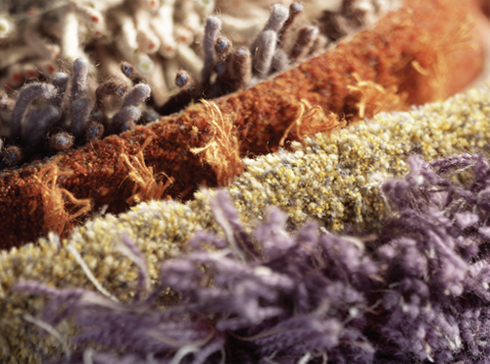
The following is the second in a series of articles that covers the component parts of the carpet, the stuff it is made out of. The word "fiber" refers to any material that can be made into filaments and yarn. A filament is a single strand of any fiber. Yarn refers to a bundle of twisted filaments. When we think of types of carpet fibers, we often make the mistake of forgetting the backing, which is also made of fibers.
During today's discussion of synthetic fibers, we will divide it into positive aspects (pros) and negative aspects (cons) to simplify and make it easier to remember.

Nylon - By far, the most popular of the man made fibers.
First, before getting to the pros and the cons, let's look briefly at the nylon "family tree", or how we arrived at the 5th generation.
1st Generation Nylon - The original carpet fibers of nylon were translucent, round fibers. This shape actually magnified dirt and any physical damage to the fiber. This made the carpet appear to be much more soiled than it actually was.
2nd Generation Nylon - Fiber manufactures went to work developing new shapes, some with hollow cores, in order to refract light differently and eliminate the magnifying effect. This greatly reduced "apparent soiling".
3rd Generation Nylon - In its original state, nylon has a problem with static electricity. In the 3rd generation, a carbon core was added to increase nylon's conductive properties. This spread any charge over a large area rather than allowing it to build up in one place.
4th Generation Nylon - Nylons are easily dyed and easily stained. A Flurochemical coating was added to increase surface tension and coat the fibers. as well as repelling dry soils.
The Pros
- Excellent Strength
- Good Elasticity (Nylon will stretch up to 33% of its length and still regain its original shape. This is very important in heavy traffic areas where furniture may be dragged across the carpet.)
- Abrasion Resistant
- Static Resistant
- Good Resiliency
- Non Absorbent
- Responds well to cleaning
- Inexpensive to manufacture
Cons
- Bleaching/Fading
Polyester - Its popularity has gone up and down like a roller coaster. Because it is relatively inexpensive to produce, manufacturers are regularly reintroducing this fiber to the carpet industry. Although it has some excellent qualities, and is a great fiber for clothing, it does have some limiting factors when used in carpet.
With the advent of microfibers, polyester has become increasingly popular as an upholstery fabric.
Pros
- Resists bleaching/fading
- Heat Resistant
- Stain Resistant
- Environmental Friendly
- Low Absorbency
Cons
- Dye Resistant
- Does not resist oil stains
- Crimp Loss (This occurs gradually from continuous stretching of the fiber due to foot traffic, furniture moving and agitation of some degree. Some fiber simply don’t spring back as well as others. This is most common with polyester fiber, no manufacturer has been able to totally resolve the problem.)
Olefin - A very versatile carpet fiber. It is also the generic name for polypropylene, a synthetic fiber used to make many different products, including carpet. In our carpet industry, the terms olefin and polypropylene are typically used interchangeably, as they both mean the same thing. You may hear the fiber referred to by either name.
Pros
- Moisture Resistant
- Chemical Resistant
- Fade Resistant
- Lightweight
- Inexpensive
- Strong
Cons
- Not Resilent
- Heat Sensitive
- Affinity for Oil
- Wicking (the upward motion of water and cleaning solution during drying from the base of a tuft to its tip carrying with it any remaining soil and contamination, which is then deposited on the tips of the tuft.)
Acrylic - This is not widely used in carpet today. It can be found blended with wool and in some products that imitate the look and feel of wool. It is also found in some inexpensive area rugs. It has many of the properties of wool and is often seen blended to reduce the price of a carpet while maintaining its appearance.
Pros
- Wool Like Properties (Soft, lightweight, dull appearance that helps hide soil.)
- Strong, Light weight
- Cleans good and Stain Release
Cons
- Resistance
- Poor Resiliency (This leads to nap reversal, pooling, and to permanent furniture marks. Nap reversal or pooling is the tendency of the nap to lie in opposite directions along an irregular line
- Browning (Sensitive to alkaline chemicals, which can lead to a form of browning.)
Synthetic Fibers
Rayon - regenerated cellulose fiber in which purified wood pulp and cotton linters have been converted into xanthate, which has then been dissolved in diluted caustic soda. This solution is pumped through a sulfuric acid bath to solidify the fibers. The resulting rayon fiber is easily dyed with bright and vivid colors. It is much more likely to be found blended in upholstery and drapery fabrics.
Acetate - this is seldom used in carpets due to its poor resiliency and wear characteristics. It is characterized by a soft, silk-like hand, and a lightweight, fast-drying, high-lustered carpet, which is often inexpensive.
I'll be happy to answer any questions you have, provide you with an estimated price over the phone, or come into your home/office and give you a free written estimate--without cost or obligation of any kind.
I hope you found this information about the other types of carpet very helpful and informative.
If you have any questions or comments, please call me at 1 800 848-8385
I've dedicated my business to consumer education and service. I'll be pleased to help you in every way. I look forward to your call.
And remember, we clean your carpet, not your wallet!

